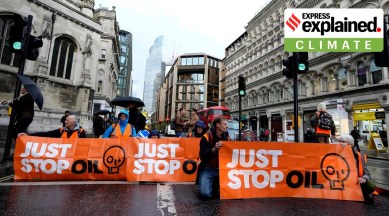Before COP27, a status check
The annual United Nations Climate Change Conference begins on Sunday. As climate challenges turn steeper, what steps are likely at the conference? What role will the Ukraine war play?

It is the time of the year when, for two weeks, climate change takes global centerstage. The annual United Nations Climate Change Conference (COP27), beginning Sunday, is being held in the Egyptian resort town of Sharm el-Shaikh amid fresh reminders that the window for meeting climate goals is closing fast.
Latest assessments suggest that current action plans of countries to meet climate goals are falling woefully short. And yet, no major win is expected at the conference, as, amid a deepening energy crisis and prevailing economic gloom, there is little appetite among countries to scale up climate action.
Emissions still rising
It’s been at least two-and-a-half decades since the world decided to restrain its greenhouse gas emissions. In absolute terms however, the annual global emissions are still rising, now touching almost 50 billion tonnes of carbon dioxide equivalent (see graph). In the decade between 2010 and 2019, the global emissions grew by over one per cent on an average. This is significantly slower than the growth in the previous decade, of about 2.6 per cent, but for meeting climate targets, is not good enough.
Moreover, even if the growth in emissions is halted immediately, or is made to decline, it does not solve the problem. This is because the warming of the planet is the result of accumulated emissions in the atmosphere and not the current emissions. Carbon dioxide, the main greenhouse gas, remains in the atmosphere for about 100 years, so that the effect of any immediate decline in emissions would have an impact only after several decades.
As a result, the average global temperatures have risen faster in the last one decade than anytime earlier (see graph). This trend is only likely to accelerate in the coming years. Recent data suggest that the annual mean temperature of the world is already higher by more than one degree Celsius from pre-industrial times. Some of the monthly means are higher by over 1.1 degree Celsius.
Response inadequate
The response in terms of emission cutshas been inadequate. The rich and industrialised countries, which were the main polluters and hence mainly responsible to bring down emissions, have not met their collective targets. Developing countries like China or India, which were not major emitters till sometime back, have seen their emissions rise steeply.
As a bloc, the European Union has done relatively better on climate goals, with the United Kingdom, which is struggling with an economic downturn right now, halving its emissions from 1990 levels, UN data shows. The United States, the world’s leading emitter till it was overtaken by China in the mid 2000s, has been a major laggard, cutting its emissions by only about 7 per cent from 1990 levels.
China’s emissions have risen by almost four times, and India’s by about three times, during this period.
Current global emissions are more than 50 per cent higher than in 1990.
World headed to 2.8-degree warming
The overall climate objective is to ensure that the rise in global temperatures does not go beyond 2 degrees compared with pre-industrial times. Preferably, it needs to be restricted within 1.5 degree Celsius.
Latest assessments suggest that if climate action is not immediately scaled up, the world is likely to become warmer by about 2.8 degree Celsius by the end of the century.
For a realistic chance to keep global warming within 1.5 degree Celsius, annual emissions would need to drop from the current level of about 50 billion tonnes of CO2 equivalent to about 33 billion tonnes by 2030 and 8 billion tonnes by 2050, according to the newest Emissions Gap Report. Even for meeting the 2-degree target, emissions have to come down to about 41 billion tonnes by 2030 and 20 billion tonnes by 2050.
This would require drastic action from all the major emitters, and looks unlikely right now. In the last one year, just about 25 countries have strengthened their 2030 climate action plans, with minimal potential to bend the emission curve.
Impact of Ukraine War
The energy and economic crisis caused by the Ukraine war is threatening to undo even the small gains made. Already, the consumption of fossil fuels has gone up. Countries have begun to secure more and more of traditional fossil fuels to deal with the uncertainty in the energy markets.
The impact of the war — which shows no signs of ending — is likely to be felt for a long time, slowing down progress on climate action by several years.
Dim expectations from Sharm el-Shaikh
Though there would be usual calls for the need to urgently scale up climate action, the Sharm el-Shaikh meeting is unlikely to deliver anything concrete. Many countries, including India, had increased their climate pledges at the Glasgow meeting last year, and it would be unrealistic to expect them to do more this time.
The impact of the war in Ukraine is likely to dominate the discussions in Egypt. Occurrence of frequent climate disasters — like the historic flooding in Pakistan — is expected to result in renewed demands for a loss and damage framework, through which affected countries can seek compensation for the damages caused by extreme events.